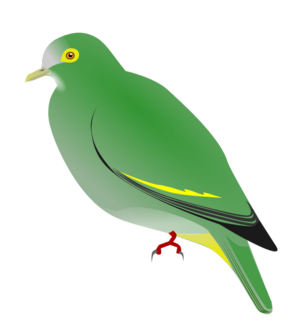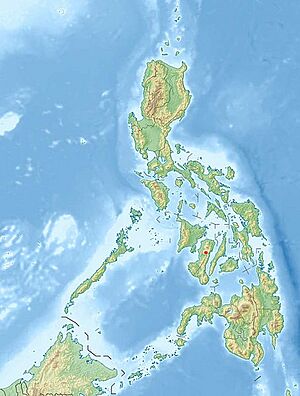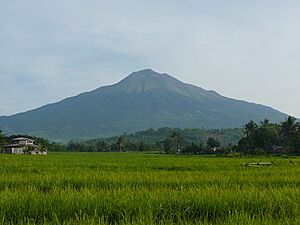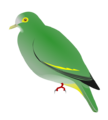Negros fruit dove facts for kids
The Negros fruit dove (Ptilinopus arcanus) is a very rare and mysterious bird from the Philippines. It belongs to the pigeon and dove family, called Columbidae. This special fruit dove is only known from one female bird found on Negros Island in 1953.
Scientists believe this bird might have lived in lowland forests but was forced to higher places because its home was destroyed. Some people wondered if the single bird found was just a strange version of another species, but most experts agree it's a unique kind of dove.
The female Negros fruit dove was a small bird with bright dark green feathers. It had a grey forehead and a cool yellow ring around its eye. When it sat, yellow edges on some of its wing feathers made it look like it had a yellow stripe on its wing. Its throat was white, and its belly and under-tail feathers were yellow.
The only time this bird was seen, it was with another bird, possibly its mate, eating fruit from a tree. Since 1953, no one has officially seen the Negros fruit dove again. Many searches have been done, but no signs of the bird have been found. Because of this, some people worry it might be extinct. However, a hunter once said he saw one in the 1990s. Also, some birds once thought to live only on Negros have been found on a nearby island called Panay. This gives scientists hope that the Negros fruit dove might still be out there!
Because it's so rare and hard to find, the IUCN (a group that tracks endangered species) lists the Negros fruit dove as Critically Endangered. This means it's in extreme danger of disappearing forever. If any of these doves are still alive, there are probably fewer than 50 of them. They would be threatened by people destroying their homes and by hunting.
Quick facts for kids Negros fruit dove |
|
|---|---|
 |
|
| General impression of female | |
| Conservation status | |
| Scientific classification | |
| Genus: |
Ptilinopus
|
| Species: |
arcanus
|
 |
|
| Red dot marking Mount Kanlaon in the Philippines | |
Contents
Discovering the Negros Fruit Dove
The Negros fruit dove was first described in 1955 by two scientists, Sidney Dillon Ripley and Dioscoro Rabor. They named it Ptilinopus arcanus. They based their description on a single female bird that Rabor found on May 1, 1953.
This special bird was found near a place called Pula, on the slopes of Mount Kanlaon in the Philippines. Rabor also saw another bird with it, which he thought was its mate, but that bird got lost in the bushes. The female bird's skin is kept safe at Yale University's Peabody Museum of Natural History.
The name Ptilinopus comes from ancient Greek words meaning "feather" and "foot." The specific name arcanus comes from a Latin word meaning "secret." This is a good name for such a mysterious bird!
Is it a Real Species?
Some people have wondered if the Negros fruit dove is a true, unique species. They thought it might be a smaller version of another dove or a mix of two different types of doves. However, most scientists do not agree with this idea. The bird found was very unique, especially the bare yellow skin around its eye. There is no real proof that it isn't its own species.
Scientists don't know exactly where this dove fits in with other Ptilinopus fruit doves. This is because the male bird's feathers, which are very important for telling these doves apart, have never been seen. Some think it might be related to the black-naped fruit dove. Others believe it might be a very old type of dove that settled in the Philippines long ago and doesn't have any close relatives left. It doesn't have any known subspecies, which means there are no different versions of it. It's also sometimes called Ripley's fruit dove.
In 2024, scientists at Yale College used special DNA tests to study the Negros fruit dove. They found that it is a very old and distinct type of fruit dove. It separated from other fruit doves almost 12 million years ago! One of the scientists, John Nash, said he would love to help find this bird again in the wild.
What the Negros Fruit Dove Looks Like
The Negros fruit dove is a small bird, about 16.5 centimeters (about 6.5 inches) long. It has a short tail. We only know what the female looks like because only one has ever been found.
The female is a beautiful, vivid dark green color all over. It has an ash-grey forehead. A wide ring of bare yellow skin goes all the way around its eye, making it look very unique. The larger feathers on its wings have bright yellow edges. When the wing is folded, these yellow edges create a clear, narrow stripe on the wing.
Its throat is white, and the feathers under its tail and around its vent (where waste leaves the body) are yellow. The bird's beak was black, and its feet were a dull purplish-red color.
Where the Negros Fruit Dove Lives
The Negros fruit dove is thought to live only on Negros Island in the central part of the Philippines. However, there is some hope that it might also be living secretly on a nearby island.
The only known birds were found in a forest on Mount Kanlaon. They were at an elevation of about 1,100 meters (about 3,600 feet) above sea level. The forest where they were found was a mix of lowland and mid-mountain forest types.
Scientists believe that this bird probably preferred to live in forests at lower altitudes. The pair found on Mount Kanlaon might have been forced to higher elevations because people were cutting down the forests in the lowlands.
How the Negros Fruit Dove Behaves
The only time anyone saw the Negros fruit dove, it was a pair of birds eating fruit from a tree. That's all we know about how it behaves! Its life is still a big mystery.
The Status of the Negros Fruit Dove
The Negros fruit dove has not been officially seen since the original pair was found in May 1953 on Mount Kanlaon. However, a local hunter in southern Negros said he shot one in the 1990s. This gives people hope that the species might still be alive.
Because it's so rare and hard to find, the IUCN lists the Negros fruit dove as Critically Endangered. This means that if it still exists, there are likely fewer than 50 of these birds left. If the species is still around, its biggest threats are people destroying its forest home for farms, wood, and charcoal. Hunting is also a big problem for all pigeons and doves on Negros Island.
Many bird collectors visited Negros before 1953 but never found this dove. This suggests that the bird was already very rare when it was first discovered. Scientists think the Negros fruit dove originally lived in lowland forests. But as people destroyed these forests in northern Negros, the doves were forced out of their ideal homes. This likely led to their possible extinction.
Today, there are no forests left in northern Negros below 750 meters (about 2,460 feet) in elevation. Several searches in the 1990s on Mount Kanlaon and the areas around it failed to find any sign that the species still exists.
However, bird experts have found that the nearby island of Panay is home to some species that were once thought to live only on Negros. One example is the Negros bleeding-heart. This discovery, along with the fact that there are still unexplored lowland forests on Panay, gives hope that the Negros fruit dove might still exist in small numbers on a nearby island.
Other than being shown on a Philippine environmental education poster in the 1990s, no special actions have been taken to protect any remaining Negros fruit doves.
Images for kids






